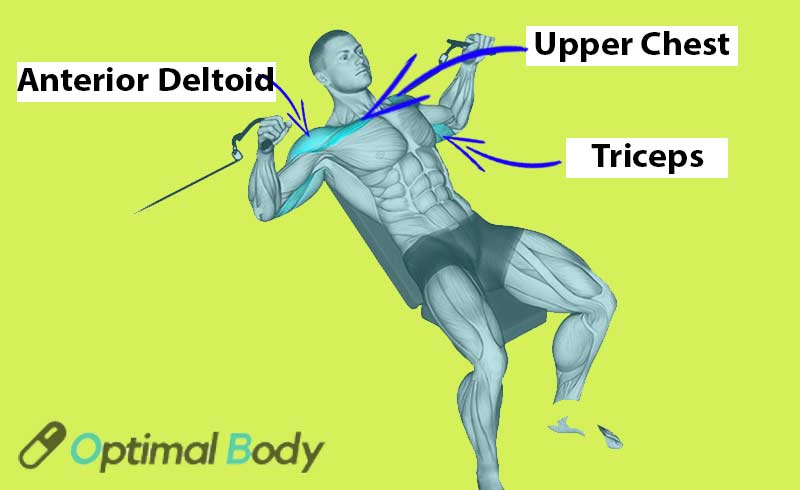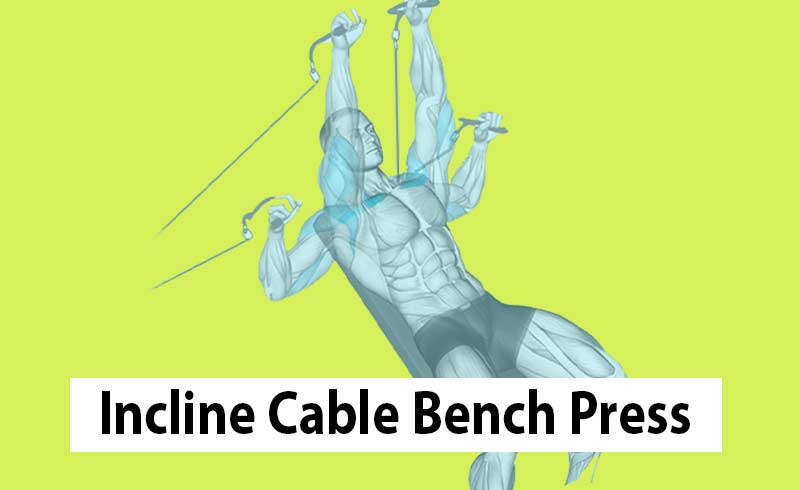If you want a simple exercise for your upper chest using a cable machine, try the incline cable press.
It’s different from other chest exercises because it focuses more on your upper chest muscles.
What is an Incline Cable Bench Press
The incline cable bench press is a complete exercise that helps strengthen and increase the size of your pectoral muscles while improving your strength.
It’s ideal for targeting the upper part of your pecs specifically.
Using the cables maintains constant tension on the muscles throughout the exercise, making it a highly effective option for developing your chest.
Incline Cable Chest Press Muscles Worked
The cable incline press works the following muscles:

Primary Muscles: Upper pectoralis major (this means it mainly targets the upper part of your chest).
Secondary Muscles: Anterior deltoid (front shoulder), triceps (back of your upper arm), and biceps brachii (front of your upper arm).
Benefits of the Incline Chest Press:
- Target Upper Pecs: It specifically focuses on the upper chest, creating a well-defined and aesthetic appearance.
- Constant Muscle Tension: The cables maintain continuous tension on the muscles, promoting better muscle fiber activation and growth.
- Reduced Joint Stress: It puts less strain on the shoulder joints compared to other chest exercises.
- Improved Stability: Engages stabilizer muscles for better balance and joint support.
- Extended Range of Motion: Allows for a wider stretch, enhancing muscle recruitment and development.
- Unilateral Training: Addresses strength imbalances between the left and right pecs.
- Functional Transfer: Strength gained carries over to other upper body pushing movements.
- Customizable: Easily adaptable for various fitness levels and goals.
How To Do Incline Cable Press the Right Way
Here’s how to properly perform the incline cable press step by step:
- Set an incline bench at approximately 30 to 45 degrees between two low pulleys.
- Lie down on the bench, ensuring your back is well-supported, and your feet are firmly planted on the ground for optimal stability.
- Hold the handles attached to the low pulleys in each hand.
- Push the handles upward, extending your arms until they are fully straightened. During this phase, exhale to exert maximum effort.
- Then, slowly lower your hands until you feel a slight stretch in your pectoral muscles. At this point, inhale.
- Repeat this movement, maintaining complete control during both the descent and ascent, until you have completed the desired number of reps.
Some tips for performing this exercise correctly:
- Avoid fully locking out your arms at the top of the movement to preserve your elbows and maintain continuous tension on your pectoral muscles.
- Before starting heavy sets, begin with lighter sets to warm up properly and prevent potential shoulder injuries.
- Change the bench position to work different angles of your upper chest.
- Squeeze your chest muscles when your hands are together to make it more effective.
- Keep the bench at about 30 to 45 degrees inclined, so the stress stays on your chest and not your shoulders.
- Focus on contracting your pectoral muscles throughout the exercise to achieve optimal muscle activation and more effective results.
Other Variations
The incline cable bench press offers a range of variations that can be incorporated into workouts to add diversity and challenge different muscle groups.
Using cables for resistance provides constant tension throughout the movement, contributing to improved muscle engagement and control.
Here are some incline cable bench press variations to consider:
1. Single Arm Incline Cable Bench Press:
Perform the incline bench press while using single handles attached to the cables.
This variation allows for greater stabilization control and focuses on each side of the chest individually.
By using single handles, you can work on any strength imbalances between your left and right sides.
2. Incline Resistance Bands Cable Press:
To increase the resistance and add variety to the exercise, combine the incline cable bench press with resistance bands.
Attach resistance bands to the cable handles or the bench press itself, and perform the movement as usual.
The bands will provide an extra challenge at the top of the press when the tension is greatest.
3. Incline Cable Press with Rotation:
Do the incline cable bench press as usual, but add a rotational component at the top of the movement.
At the peak of the press, rotate your hands inward, so your palms face each other.
This rotation engages the chest muscles further and challenges stability.
4. Incline Cable Flyes:
Incline cable flye is an effective exercise that primarily targets the upper chest muscles and helps develop a well-rounded chest appearance.
This exercise is performed using a cable machine with pulleys set at an elevated position.
Top 9 Cable Incline Chest Press Alternatives
Incorporate various cable incline bench press alternatives to keep your workouts challenging and cater to your skill level.
You can focus on specific muscle areas with different variations.
1. Incline Bench Press Using Smith Machine or Barbell:
Use a barbell instead of dumbbells for added weight, but ensure you master the technique to avoid injury. Having a spotter is recommended if you don’t use a Smith machine.
2. Dumbbell Incline Bench Press:
Similar to the cable bench press, the dumbbell incline bench press targets the upper chest but provides more freedom of movement and stabilizer muscle activation.
3. Dumbbell Incline Bench Press with Rotation:
Work on your chest, front deltoids, triceps, coracobrachialis, and serratus anterior. Execute the movement correctly, controlling the descent and focusing on proper form.
4. Chest Dips:
Chest dips primarily target the lower chest but also engage the upper chest and triceps. Use parallel bars or dip bars, lower your body, and then push back up.
5. Incline Cable Chest Flyes:
Performing the incline cable chest flyes on a flat bench or an incline bench can effectively target the chest muscles.
Stand facing the cable machine, hold the handles with your arms outstretched, and bring your hands together in front of your chest while maintaining a slight bend in your elbows.
6. Incline Cable Crossover:
On both sides of the cable machine, set the pulleys to their highest setting. Face away from the machine as you stand in the center of it.
Bring your arms together in front of your chest in a crossing motion, with your arms extended and slightly bent.
This exercise focuses on the muscle squeeze at the height of the movement and targets the upper chest.
7. Landmine Press:
The landmine press is a unique exercise that challenges the upper chest and shoulders. Secure one end of a barbell in a landmine or corner, and press the other end upward at an incline.
8. Resistance Band Chest Press:
Using resistance bands to mimic the bench press movement can be a convenient alternative, especially when access to equipment is limited. Anchor the bands at chest height and press them forward while standing or on an incline bench.
9. Incline Chest Press Machine
The Incline Chest Press Machine exercise is a strength training exercise that targets the upper chest muscles. It is performed using a chest press machine with an adjustable incline bench.
Some machines may have different handle positions or grip options, allowing you to target the chest muscles from different angles.
Decline Cable Press Vs Incline: What are the differences?
The decline cable bench press and incline cable bench press are two variations of the traditional bench press exercise that target different areas of the chest. Here’s a comparison of the two:
Decline Cable Bench Press:
- Body Position: In the decline cable bench press, the bench is set at a downward angle (around 15 to 30 degrees), with the head positioned lower than the feet. This positioning targets the lower pectoral muscles.
- Muscle Emphasis: The decline angle places more emphasis on the lower chest, helping to develop and strengthen the sternal head of the pectoralis major muscle.
- Secondary Muscles: Along with the lower chest, the decline bench press also engages the triceps, shoulders, and core muscles for stabilization.
- Range of Motion: This exercise provides a greater range of motion than traditional decline barbell or dumbbell presses, as the cables allow for better stretch and muscle activation throughout the movement.
Incline Cable Bench Press:
- Body Position: In the incline cable bench press, the bench is set at an upward angle (around 30 to 45 degrees), with the head positioned higher than the feet. This targets the upper chest muscles.
- Muscle Focus: The incline angle primarily targets the clavicular head of the pectoralis major muscle, assisting in the development and strengthening of the upper chest.
- Secondary Muscles: The incline bench press works the front deltoids, triceps, and stabilizing core muscles in addition to the upper chest.
- Range of Motion: The incline version, like the decline cable bench press, has a wider range of motion than typical incline barbell or dumbbell presses, enabling stronger muscle activation.
References:
- Gentil P, Soares S, Bottaro M. Single vs. Multi-Joint Resistance Exercises: Effects on Muscle Strength and Hypertrophy. Asian J Sports Med. 2015 Jun;6(2):e24057. doi: 10.5812/asjsm.24057. Epub 2015 Jun 22. PMID: 26446291; PMCID: PMC4592763.
Avelar A, Ribeiro AS, Nunes JP, Schoenfeld BJ, Papst RR, Trindade MCC, Bottaro M, Cyrino ES. Effects of order of resistance training exercises on muscle hypertrophy in young adult men. Appl Physiol Nutr Metab. 2019 Apr;44(4):420-424. doi: 10.1139/apnm-2018-0478. Epub 2018 Sep 24. PMID: 30248269.
- Alan C. Cudlip, Jacquelyn M. Maciukiewicz, Brendan L. Pinto, Clark R Dickerson. (2022) Upper extremity muscle activity and joint loading changes between the standard and powerlifting bench press techniques. Journal of Sports Sciences 40:9, pages 1055-1063.
- https://www.bodybuilding.com/exercises/incline-cable-chest-press
- Hélio V. Cabral, Leonardo M. L. de Souza, Liliam F. Oliveira, Taian M. Vieira. (2022) Non‐uniform excitation of the pectoralis major muscle during flat and inclined bench press exercises. Scandinavian Journal of Medicine & Science in Sports 32:2, pages 381-390.
Crossref
- Bench Press Calculator - April 22, 2024
- Press to Handstand: Ultimate Step-by-Step Guide - April 22, 2024
- Cable Press (How To Do, Benefits, Targeted Muscles, Alternative) - April 22, 2024

